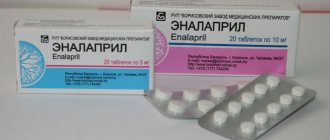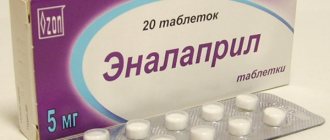Renipril®
Caution must be exercised when prescribing Renipril® to patients with reduced circulating blood volume (as a result of diuretic therapy, limiting salt intake, hemodialysis, diarrhea and vomiting) - the risk of a sudden and pronounced decrease in blood pressure is increased after using even the initial dose of an ACE inhibitor. Transient arterial hypotension is not a contraindication for continuing treatment with the drug after stabilization of blood pressure. In case of a repeated pronounced decrease in blood pressure, the dose should be reduced or the drug discontinued.
The use of high-permeability dialysis membranes increases the risk of developing an anaphylactic reaction. Correction of the dosage regimen on days free from dialysis should be carried out depending on the level of blood pressure.
Before and during treatment with ACE inhibitors, periodic monitoring of blood pressure, blood parameters (concentration of hemoglobin, potassium, creatinine, urea, liver enzyme activity), and protein in the urine is necessary.
Patients with severe heart failure, coronary heart disease and cerebrovascular disease, in whom a sharp decrease in blood pressure can lead to myocardial infarction, stroke or impaired renal function, should be carefully monitored.
Sudden cessation of treatment does not lead to withdrawal syndrome (a sharp rise in blood pressure).
For newborns and infants who have been exposed in utero to ACE inhibitors, it is recommended to conduct careful monitoring for timely detection of a pronounced decrease in blood pressure, oliguria, hyperkalemia and neurological disorders that may be due to a decrease in renal and cerebral blood flow with a decrease in blood pressure caused by ACE inhibitors. In oliguria, it is necessary to maintain blood pressure and renal perfusion by administering appropriate fluids and vasoconstrictors.
Before studying the functions of the parathyroid glands, the drug should be discontinued. Alcohol enhances the hypotensive effect of the drug.
Before surgery (including dentistry), the surgeon/anesthesiologist must be warned about the use of ACE inhibitors.
In the presence of renal failure, the excretion of the active metabolite may be reduced, leading to an increase in its concentration in the blood plasma. Such patients may need to be prescribed smaller doses of the drug.
In patients with arterial hypertension and unilateral or bilateral renal artery stenosis, an increase in urea and creatinine in the blood serum is possible.
In such patients, renal function should be monitored during the first few weeks of therapy. It may be necessary to reduce the dosage of the drug.
The balance of risk and potential benefit should be taken into account when prescribing Renipril® to patients with coronary and cerebrovascular insufficiency due to the risk of increased ischemia with excessive arterial hypotension.
The drug should be prescribed with caution to patients with diabetes mellitus due to the risk of developing hyperkalemia.
Patients with a history of angioedema may have an increased risk of developing angioedema during treatment with Renipril.
Patients with significant autoimmune diseases, such as systemic lupus erythematosus or scleroderma, are at increased risk of developing neutropenia or agranulocytosis while taking Renipril®.
Caution is recommended when prescribing Renipril® for the treatment of chronic heart failure in patients receiving cardiac glycosides and/or diuretics.
Enalapril, 5 mg, tablets, 20 pcs.
There is no experience with the use of enalapril in patients who have recently undergone kidney transplantation. Therefore, the use of this drug in such patients is not recommended.
The use of Enalapril in patients with liver failure usually does not require dose adjustment. Rarely, taking an ACE inhibitor is associated with a syndrome ranging from the development of cholestatic jaundice to the development of fulminant liver necrosis. If symptoms of jaundice or increased activity of liver enzymes appear in patients taking ACE inhibitors, discontinue drug therapy and conduct an appropriate examination. In patients taking ACE inhibitors, cases of neutropaeia/agranulocytosis, thrombocygopenia and anemia have been reported. In patients with normal renal function and no other complications, neugropenia rarely develops. The drug Enalapril should be used with great caution in patients with connective tissue diseases (including systemic lupus erythematosus scleroderma) who are simultaneously receiving immunosuppressive therapy with allopurinol or procainamide, as well as a combination of these factors, especially with existing renal dysfunction. These patients may develop severe infections that do not respond to intensive antibiotic therapy. If patients still take the drug Enalapril, it is recommended to periodically monitor the number of leukocytes in the blood. The patient should be warned that if any signs of infection appear, they should consult a doctor.
Angioedema of the face, extremities of the tongue, vocal cords and/or larynx has been reported with the use of ACE inhibitors, including enalapril. This can happen at any time during treatment. In such cases, treatment with Enalapril should be stopped immediately and the patient should be under medical supervision until the corresponding symptoms completely disappear. Even in cases where only difficulty in swallowing occurs without difficulty breathing, patients may require long-term medical supervision because Therapy with antihistamines and glucocorticosteroids may not be enough. Angioedema associated with swelling of the larynx and tongue can be fatal in very rare cases. Patients with swelling of the vocal cords or larynx may develop airway obstruction, especially in patients with a history of respiratory surgery. In cases of airway obstruction, it is necessary to carry out appropriate therapy as soon as possible, including subcutaneous administration of epinephrine (03-05 ml of epinephrine (adrenaline) solution in a ratio of 1:1000) and/or take the necessary measures to ensure the conductivity of the airways (intubation or tracheostomy).
Among black patients receiving ACE inhibitor therapy, the incidence of angioedema is higher than among patients of other races. Patients with a history of angioedema not associated with the use of ACE inhibitors have an increased risk of developing angioedema when taking any ACE inhibitor.
There are reports of the development of life-threatening anaphylactic reactions in patients taking ACE inhibitors. during the desensitization procedure with hymenoptera venom. Such reactions can be avoided if you temporarily stop taking ACE inhibitors before desensitization begins. The use of ACE inhibitors should be avoided in patients receiving bee venom immunotherapy.
In rare cases, life-threatening anaphylactoid reactions have been observed in patients taking ACE inhibitors during LDL apheresis with dextrin sulfate. If LDL-afsrez inhibitors are used, AIF inhibitors should be temporarily replaced with other drugs for the treatment of arterial hypertension and heart failure.
Anaphylactoid reactions have been reported in patients undergoing hemodialysis using high-flux polyacrylonitrile membranes (AN69). In these cases, it is recommended to use a different type of membrane for dialysis or use an antihypertensive drug of a different pharmacotherapeutic group.
When using the drug Enalapril in patients with diabetes mellitus receiving hypoglycemic agents for oral administration or insulin during the first month of therapy, it is necessary to regularly monitor the concentration of glucose in the blood.
Cough has been reported with the use of ACE inhibitors. Usually the cough is non-productive and persistent and stops after discontinuation of ACE inhibitors. In the differential diagnosis of cough, cough caused by the use of ACE inhibitors must also be taken into account. In patients undergoing surgery or during general anesthesia with the use of drugs that cause arterial hypotension, ACE inhibitors may block the formation of angiotensin II in response to compensatory release of renin. Before surgery (including dental procedures), it is necessary to warn the surgeon-anesthesiologist about the use of Enalapril.
Side effects
From the nervous system and sensory organs: dizziness, headache, weakness, increased fatigue, decreased libido.
From the cardiovascular system and blood (hematopoiesis, hemostasis): hypotension, collapse, neutropenia, hyperkalemia.
From the gastrointestinal tract: nausea, impaired liver function (increased activity of liver transaminases, bilirubin levels), diarrhea.
Other: cough, skin rashes, renal dysfunction, proteinuria, muscle spasms, angioedema.
Enalapril Renipril
Trade name: Renipril International name: Enalapril Pharmacological group: ACE inhibitor Pharmacological group according to ATC: C09AA02. Enalapril Pharmacodynamics: An ACE inhibitor is an antihypertensive drug, the mechanism of action is associated with a decrease in the formation of angiotensin II from angiotensin I, a decrease in the concentration of which leads to a direct decrease in aldosterone secretion. At the same time, peripheral resistance, systolic and diastolic blood pressure, post- and preload on the myocardium decrease. Dilates arteries to a greater extent than veins, while no reflex increase in heart rate is observed. Reduces bradykinin degradation, increases Pg synthesis. The hypotensive effect is more pronounced at high plasma renin concentrations than at normal or reduced levels. A decrease in blood pressure within therapeutic limits does not affect cerebral circulation; blood flow in the vessels of the brain is maintained at a sufficient level even against the background of reduced blood pressure. Strengthens coronary and renal blood flow. With long-term use, hypertrophy of the LV myocardium and myofibril of the walls of resistive arteries decreases, prevents the progression of CHF and slows down the development of LV dilatation. Improves blood supply to ischemic myocardium. Reduces platelet aggregation. Extends life expectancy in patients with CHF, slows down the progression of LV dysfunction in patients who have had myocardial infarction without clinical manifestations of HF. Has some diuretic effect. Reduces intraglomerular hypertension, slowing the development of glomerulosclerosis and the risk of chronic renal failure. Enalapril is a “prodrug”: as a result of its hydrolysis, enalaprilat is formed, which inhibits ACE. The onset of the hypotensive effect when taken orally is 1 hour, it reaches a maximum after 4-6 hours and lasts up to 24 hours. In some patients, therapy is required for several weeks to achieve an optimal blood pressure level. In CHF, a noticeable clinical effect is observed with long-term treatment - 6 months or more.
Pharmacokinetics: After oral administration, absorption is 60%. Eating does not affect absorption. It is metabolized in the liver to form the active metabolite enalaprilat, which is a more effective ACE inhibitor than enalapril. Plasma protein binding of enalaprilat is 50-60%. TCmax of enalapril - 1 hour, enalaprilat - 3-4 hours. Enalaprilat easily passes through histohematic barriers, excluding the BBB, a small amount penetrates the placenta and into breast milk. T1/2 of enalaprilat - 11 hours. Excreted mainly by the kidneys - 60% (20% - in the form of enalapril and 40% - in the form of enalaprilat), through the intestines - 33% (6% - in the form of enalapril and 27% - in the form of enalaprilat) . It is removed by hemodialysis (rate 62 ml/min) and peritoneal dialysis.
Indications for use: Arterial hypertension (symptomatic, renovascular, including with scleroderma, etc.), stage I-III CHF, prevention of coronary ischemia in patients with LV dysfunction, asymptomatic LV dysfunction.
Contraindications: Hypersensitivity to enalapril or other ACE inhibitors, pregnancy, lactation.
With caution: history of angioedema during therapy with ACE inhibitors, hereditary or idiopathic angioedema, aortic stenosis, cerebrovascular diseases (including cerebrovascular insufficiency), coronary artery disease, coronary insufficiency, severe autoimmune systemic connective tissue diseases (including including SLE, scleroderma), suppression of bone marrow hematopoiesis, diabetes mellitus, hyperkalemia, bilateral renal artery stenosis, stenosis of the artery of a single kidney, condition after kidney transplantation, renal and/or liver failure, Na+-restricted diet, conditions accompanied by a decrease in blood volume (in including diarrhea, vomiting), old age, age under 18 years (safety and effectiveness of use have not been studied).
Dosage regimen: Orally, regardless of food intake. For monotherapy of arterial hypertension, the initial dose is 5 mg once a day. If there is no effect, after 1-2 weeks the dose is increased by 5 mg. After the initial dose, patients should be under medical supervision for 2 hours and an additional 1 hour until blood pressure stabilizes. If necessary and sufficiently well tolerated, the dose can be increased to 40 mg/day in 1-2 doses. After 2-3 weeks, switch to a maintenance dose - 10-40 mg/day, divided into 1-2 doses. For moderate hypertension, the average daily dose is about 10 mg. The maximum daily dose of the drug is 40 mg. If prescribed to patients concomitantly receiving diuretics, treatment with the diuretic should be discontinued 2-3 days before enalapril is prescribed. If this is not possible, then the initial dose of enalapril should be 2.5 mg/day. For patients with hyponatremia (serum Na+ concentration less than 130 mmol/l) or serum creatinine concentration more than 0.14 mmol/l, the initial dose is 2.5 mg 1 time per day. Renovascular hypertension: initial dose - 2.5-5 mg/day. The maximum daily dose is 20 mg. In severe cases of arterial hypertension, intravenous administration is possible (see Enalaprilat), carried out only in a hospital setting. For CHF, the initial dose is 2.5 mg once, then the dose is increased by 2.5-5 mg every 3-4 days in accordance with the clinical response to the maximum tolerated dose (depending on blood pressure), but not higher than 40 mg/day, once, or in 2 doses. In patients with low systolic blood pressure (less than 110 mm Hg), therapy should begin with a dose of 1.25 mg. Dose selection should be carried out over 2-4 weeks or shorter periods. The average maintenance dose is 5-20 mg/day in 1-2 doses. In the elderly, a more pronounced hypotensive effect and prolongation of the drug's action time are more often observed, which is associated with a decrease in the rate of elimination of enalapril, therefore the recommended initial dose for the elderly is 1.25 mg. For asymptomatic dysfunction of the LV function - 2.5 mg 2 times a day. The dose is selected taking into account tolerability up to 20 mg/day, divided into 2 doses. In chronic renal failure, cumulation occurs when filtration decreases to less than 10 ml/min. With CC 80-30 ml/min, the dose is usually 5-10 mg/day, CC 30-10 ml/min - 2.5-5 mg/day, less than 10 ml/min - 1.25-2.5 mg/day only on dialysis days. The duration of treatment depends on the effectiveness of the therapy. If the decrease in blood pressure is too pronounced, the dose of the drug is gradually reduced.
Side effects: From the cardiovascular system: excessive decrease in blood pressure, orthostatic collapse, rarely - chest pain, angina pectoris, myocardial infarction (usually associated with a pronounced decrease in blood pressure), arrhythmias (atrial brady- or tachycardia, atrial fibrillation), palpitations, thromboembolism of the branches of the pulmonary artery . From the nervous system: dizziness, fainting, headache, weakness, insomnia, paresthesia, anxiety, depression, confusion, fatigue, drowsiness (2-3%), very rarely when used in high doses - nervousness, depression, paresthesia . From the senses: disorders of the vestibular apparatus, hearing and vision impairment, tinnitus. From the digestive system: dry mouth, loss of appetite, dyspeptic disorders (nausea, diarrhea or constipation, vomiting, abdominal pain), intestinal obstruction, pancreatitis, impaired liver function and bile secretion, hepatitis, jaundice. From the respiratory system: nonproductive “dry” cough, interstitial pneumonitis, bronchospasm, shortness of breath, rhinorrhea, pharyngitis. Allergic reactions: skin rash, angioedema of the face, limbs, lips, tongue, glottis and/or larynx, dysphonia, exfoliative dermatitis, exudative erythema multiforme (including Stevens-Johnson syndrome), toxic epidermal necrolysis (Lyell's syndrome) , pemphigus (pemphigus), pruritus, urticaria, photosensitivity, serositis, vasculitis, myositis, arthralgia, arthritis, stomatitis, glossitis. From laboratory parameters: hypercreatininemia, increased urea concentration, increased activity of “liver” transaminases, hyperbilirubinemia, hyperkalemia, hyponatremia, decreased Hb and hematocrit, increased ESR, thrombocytopenia, neutropenia, agranulocytosis (in patients with autoimmune diseases), eosinophilia. From the urinary system: impaired renal function, proteinuria. Other: alopecia, decreased libido, flushing of the face.
Overdose: Symptoms: excessive decrease in blood pressure, up to the development of collapse, myocardial infarction, acute cerebrovascular accident or thromboembolic complications, convulsions, stupor. Treatment: the patient is transferred to a horizontal position with a low headboard. In mild cases, gastric lavage and ingestion of saline solution are indicated; in more serious cases, measures aimed at stabilizing blood pressure are indicated: intravenous administration of a 0.9% NaCl solution, plasma substitutes, if necessary, intravenous administration of angiotensin II, hemodialysis (enalaprilat elimination rate - 62 ml/min).
Interaction: Enhances the effect of ethanol, slows down the excretion of Li+. Weakens the effect of drugs containing theophylline. The hypotensive effect is reduced by NSAIDs and estrogens, and enhanced by diuretics, other antihypertensive drugs (beta-blockers, methyldopa, nitrates, BMCA, hydralazine, prazosin), drugs for general anesthesia, ethanol. Potassium-sparing diuretics and potassium-containing drugs increase the risk of developing hyperkalemia. Drugs that cause bone marrow suppression increase the risk of developing neutropenia and/or agranulocytosis. Immunosuppressants, allopurinol, cytostatics increase hematotoxicity.
Special instructions: Care must be taken when prescribing to patients with reduced blood volume (as a result of diuretic therapy, limiting salt intake, hemodialysis, diarrhea and vomiting) - the risk of a sudden and pronounced decrease in blood pressure is increased after using even the initial dose of an ACE inhibitor. Transient hypotension is not a contraindication for continuing treatment with the drug after stabilization of blood pressure. In case of a repeated pronounced decrease in blood pressure, the dose should be reduced or the drug discontinued. If an excessive decrease in blood pressure develops, the patient is transferred to a horizontal position with a low head, and, if necessary, a 0.9% NaCl solution and plasma-substituting drugs are administered. The use of high-flow dialysis membranes increases the risk of developing an anaphylactic reaction. Correction of the dosage regimen on days free from dialysis should be carried out depending on the level of blood pressure. Before and during treatment with ACE inhibitors, it is necessary to monitor blood pressure, blood parameters (Hb, K+, creatinine, urea, liver enzyme activity), and protein in the urine. Patients with decompensated CHF, ischemic heart disease and cerebral vascular diseases, in whom a sharp decrease in blood pressure can lead to myocardial infarction, stroke or impaired renal function, should be carefully monitored. Sudden cessation of treatment does not lead to withdrawal syndrome (a sharp rise in blood pressure). Patients with a history of angioedema have an increased risk of developing it when taking ACE inhibitors. For newborns and infants who have been exposed in utero to ACE inhibitors, it is recommended to conduct careful monitoring for timely detection of a pronounced decrease in blood pressure, oliguria, hyperkalemia and neurological disorders that may be due to a decrease in renal and cerebral blood flow with a decrease in blood pressure caused by ACE inhibitors. With oliguria, it is necessary to maintain blood pressure and renal perfusion by administering appropriate fluids and vasoconstrictor drugs. In patients with reduced renal function, the single dose should be reduced or the intervals between doses should be increased. Before studying the functions of the parathyroid glands, enalapril should be discontinued. Caution should be exercised when performing physical exercise or in hot weather (risk of dehydration and excessive reduction in blood pressure due to a decrease in blood volume). Before surgery (including dentistry), the surgeon/anesthesiologist must be warned about the use of ACE inhibitors. During the treatment period, care must be taken when driving vehicles and engaging in other potentially hazardous activities that require increased concentration and speed of psychomotor reactions (dizziness is possible, especially after taking the initial dose of an ACE inhibitor in patients taking diuretic drugs).
Manufacturer: Pharmstandard-Leksredstva OJSC, Russia Registration certificate holder: Pharmstandard-Leksredstva OJSC, Russia Release form: 20 mg tablets, blister packs Belongs to VED Minimum pharmacy assortment Preferential dispensing: DLO Dispensing conditions: by prescription Registration data: P N000084/ 01 from 06.28.2010 Status of the registration certificate: valid Pharmaceutical article number: FSP 42-0550-0293-06






